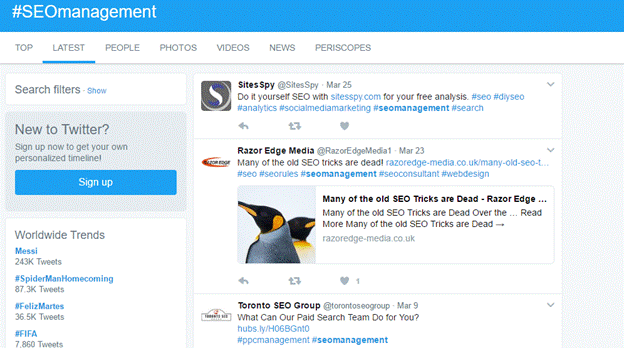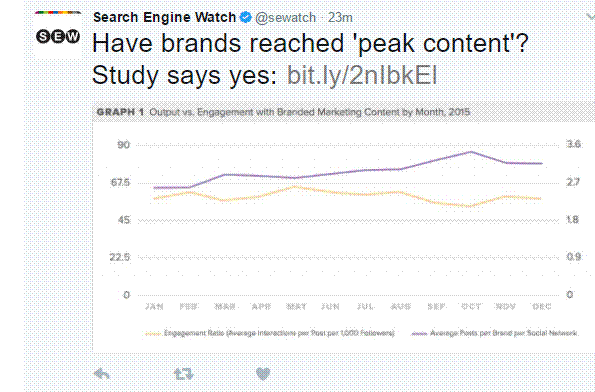Digital Marketing
Why Social Media Marketing is Important for Your Business
Published
7 months agoon
By
admin
In today’s digital age, the significance of social media marketing (SMM) cannot be overstated. Businesses, both large and small, are increasingly adopting social media as a key tool in their marketing strategies. Social media platforms have become a central hub for engagement, branding, customer service, and even sales. With billions of people using social media daily, harnessing its power to promote your business can yield remarkable results. But why is social media marketing so crucial, and how can it propel your business to new heights?
In this comprehensive guide, we will explore the multifaceted importance of social media marketing for businesses. From increasing brand awareness to driving traffic and sales, here are the reasons why every modern business needs to invest in social media marketing.
1. Increased Brand Awareness
One of the most significant benefits of social media marketing is its ability to increase brand awareness. Social media platforms like Facebook, Instagram, Twitter, LinkedIn, and TikTok have millions (if not billions) of active users. Every post, tweet, and shared video has the potential to reach a vast audience, far beyond your traditional marketing methods.
When businesses engage consistently on social media, they have the chance to introduce their brand to new users. Through organic posts, paid ads, and influencer collaborations, your brand can stay at the forefront of your audience’s mind. This constant exposure helps to build recognition and trust, making your brand the go-to choice for your products or services.
In addition, social media platforms allow businesses to interact with their audience directly. Whether it’s through comments, messages, or reviews, this engagement further solidifies your brand’s presence in the marketplace. Brands that are active on social media are seen as more credible and trustworthy, and this contributes significantly to long-term business success.
2. Improved Customer Engagement
Social media allows businesses to engage with their customers in ways that traditional marketing methods cannot. Platforms like Facebook, Twitter, and Instagram offer opportunities for real-time interactions with customers. This engagement is valuable because it creates a sense of community around your brand.
Through social media, businesses can reply to customer inquiries, address complaints, and even receive feedback about their products or services. This two-way communication fosters a positive relationship between brands and customers, leading to increased customer loyalty and satisfaction.
Additionally, engagement on social media platforms can help businesses better understand their target audience. By analyzing engagement metrics such as likes, shares, comments, and views, businesses can gain insights into their customers’ preferences, needs, and pain points. This information can be used to fine-tune marketing strategies, improve products or services, and enhance the overall customer experience.
3. Cost-Effective Marketing
Social media marketing is one of the most cost-effective strategies available for businesses. Compared to traditional forms of advertising like print ads, TV commercials, or billboards, social media marketing requires a much smaller budget to get started.
Creating an account on platforms like Facebook, Instagram, or LinkedIn is free, and businesses can start posting content without spending a dime. Even when using paid advertising on social media, the cost is relatively low, especially when compared to other advertising channels. Social media ads can be highly targeted, ensuring that your marketing dollars are spent efficiently by reaching the people who are most likely to be interested in your products or services.
Moreover, with social media’s tracking and analytics tools, businesses can measure the effectiveness of their campaigns in real time. This enables them to adjust their strategies on the fly, making it easier to optimize their spending and ensure a positive return on investment (ROI).
4. Increased Website Traffic and SEO Ranking
Social media marketing is a powerful tool for driving traffic to your website. When businesses post links to their website content or product pages on social media, they create an easy way for potential customers to learn more about their offerings. As more people click on these links, website traffic increases, which can lead to higher sales and conversions.
Additionally, search engines like Google take social signals into account when determining rankings. A strong social media presence can contribute to a higher SEO ranking, which makes it easier for your target audience to find your business online. Social media content, such as blog posts, videos, and infographics, can also improve your search visibility by driving more traffic to your website.
In essence, social media and SEO work hand in hand to boost your online presence. When your website gets more traffic and your content gets shared on social platforms, it signals to search engines that your business is authoritative and relevant in your industry. This can help your website rank higher in search results, making it more visible to potential customers.
5. Targeted Advertising
One of the most powerful features of social media marketing is the ability to target specific audiences with precision. Social media platforms provide advanced targeting options that allow businesses to reach users based on demographics, location, interests, behaviors, and even specific keywords.
For example, Facebook Ads Manager lets businesses create highly targeted campaigns that are shown only to people who are most likely to be interested in their products or services. These targeting options ensure that your ads are being seen by the right people at the right time, increasing the likelihood of generating leads and making sales.
Additionally, social media platforms gather a wealth of data about their users, which can be leveraged to create highly personalized ad experiences. Personalized ads tend to resonate more with users, which can result in better engagement rates, higher conversion rates, and a stronger connection between your brand and its audience.
6. Building Trust and Credibility
In an era where consumers have access to endless options and information, trust and credibility are critical for a business’s success. Social media allows brands to build credibility by sharing content that demonstrates expertise, authority, and authenticity.
Through consistent posting of valuable content, businesses can position themselves as industry leaders. This can include blog posts, helpful tips, tutorials, behind-the-scenes glimpses, or case studies that showcase your product’s effectiveness. By providing value, businesses can establish themselves as trustworthy sources of information.
In addition, social media enables businesses to gather customer reviews, testimonials, and user-generated content that can be shared with a broader audience. Positive reviews and endorsements from satisfied customers help to build social proof, which can increase consumer trust in your brand.
7. Enhanced Customer Insights
Social media is a goldmine of customer data. Every interaction, comment, and like provides valuable insights into what your customers are thinking, what they care about, and what they want from your business.
By using social media analytics tools, businesses can gain a deeper understanding of their audience’s behaviors and preferences. This information can be used to refine marketing strategies, create more relevant content, and even develop new products or services that meet customer needs.
Furthermore, social media allows businesses to conduct surveys, polls, and questionnaires to gather even more targeted feedback from their audience. This helps businesses make data-driven decisions that can lead to improved customer satisfaction and increased sales.
8. Competitive Advantage
In a competitive marketplace, staying ahead of the competition is key to business success. Social media marketing provides businesses with an opportunity to monitor their competitors’ activities and learn from their successes and failures.
By keeping an eye on your competitors’ social media strategies, you can identify trends, gaps, and opportunities that can be leveraged to your advantage. If a competitor is successfully using a particular social platform or content type, you can adopt similar strategies or differentiate your brand by offering something unique.
Moreover, actively engaging with your audience on social media can help you build stronger relationships with your customers, giving you a competitive edge over businesses that aren’t as responsive or engaged online.
9. Increased Sales and Conversions
Ultimately, one of the most compelling reasons to invest in social media marketing is its ability to drive sales and conversions. Social media platforms offer businesses the ability to directly sell products through features like Facebook Shops, Instagram Shopping, and shoppable posts.
By integrating e-commerce features into social media, businesses can streamline the purchasing process for customers, making it easier for them to make a purchase without ever leaving the platform. This seamless shopping experience has been proven to increase conversion rates and boost sales.
Furthermore, social media ads are designed to drive action. With strategically placed calls-to-action (CTAs), businesses can encourage users to take specific actions, such as signing up for a newsletter, downloading an app, or making a purchase. The ability to directly target users who are most likely to convert makes social media an invaluable tool for driving business growth.
10. Global Reach
Social media breaks down geographic barriers, enabling businesses to reach a global audience. With platforms like Facebook, Instagram, and LinkedIn available in multiple languages and accessible across borders, businesses can connect with potential customers from all over the world.
This global reach opens up new markets and opportunities for businesses that may not have been possible through traditional marketing channels. By engaging with international customers, businesses can expand their customer base and increase their potential for growth.
Conclusion
Social media marketing is not just a passing trend; it is an essential aspect of modern business strategy. The ability to increase brand awareness, engage with customers, drive traffic, target specific audiences, and boost sales makes social media a powerful tool for businesses of all sizes.
By embracing social media marketing, businesses can build stronger relationships with their audience, stay ahead of the competition, and ultimately drive growth and success. Whether you’re just getting started or looking to refine your current strategy, social media offers endless opportunities to take your business to the next level. If you’re not already utilizing social media marketing to its full potential, now is the time to start. The future of business is online, and social media is the key to unlocking your brand’s success.
You may like
Digital Marketing
What Are the Most Effective Digital Marketing Strategies?
Published
3 weeks agoon
June 20, 2025By
admin
In today’s hyper-connected digital world, standing out amidst the noise is one of the biggest challenges for businesses. With more than 5 billion internet users globally, the potential reach of digital marketing has never been greater. Yet, the question remains: what are the most effective digital marketing strategies that truly drive results?
From startups to established enterprises, businesses are constantly exploring ways to maximize their online visibility, engage their audience, and boost conversions. Whether you’re a small business owner or a digital marketing professional, understanding how to leverage the right strategy can be the difference between fading into obscurity and becoming a household name.
This blog will break down everything you need to know about creating a powerful digital marketing strategy, including actionable tips and examples of successful campaigns that made waves.
What is a Digital Marketing Strategy?
A digital marketing strategy is a comprehensive plan that outlines how a business will use digital channels to achieve its marketing goals. These channels can include search engines, social media platforms, email, websites, and more. The strategy serves as a roadmap that helps businesses:
- Identify their target audience
- Set measurable objectives
- Allocate resources efficiently
- Analyze and optimize campaign performance
A successful digital marketing strategy is customer-centric, data-driven, and aligned with the overall business goals. It’s not just about being present online but about being strategically present.
4 Tips for Creating an Effective Digital Strategy
Creating an effective digital marketing strategy requires thoughtful planning and ongoing optimization. Here are four crucial tips to guide you:
1. Understand Your Customer
Everything begins with the customer. Your digital marketing strategy should revolve around understanding:
- Who your customers are
- What their needs and pain points are
- Where they spend their time online
- How they make purchasing decisions
Use tools like Google Analytics, Facebook Audience Insights, and customer surveys to gather demographic and psychographic data. Develop detailed buyer personas to humanize your audience and guide your messaging.
2. Audit & Assess
Before crafting new strategies, conduct a comprehensive audit of your current marketing efforts. Assess:
- Website performance (load speed, mobile responsiveness, user experience)
- Content quality and reach
- SEO health (backlinks, keywords, rankings)
- Social media engagement
- Email open and click-through rates
A SWOT analysis (Strengths, Weaknesses, Opportunities, Threats) is also helpful to identify where you stand and where to improve.
3. Focus on the End Result
Your strategy should be goal-oriented. Ask yourself:
- Are you trying to increase brand awareness?
- Do you want to generate more leads?
- Are you focused on boosting online sales?
Use SMART goals (Specific, Measurable, Achievable, Relevant, Time-bound) to give your campaigns a clear direction. For example: “Increase website traffic by 20% in 3 months through SEO and social media marketing.”
4. Review and Refine
Digital marketing is not a set-it-and-forget-it process. Regularly monitor KPIs such as:
- Conversion rates
- Bounce rates
- Cost-per-click (CPC)
- Return on investment (ROI)
Use analytics tools like Google Analytics, SEMrush, HubSpot, and social media insights to evaluate performance and refine your strategies accordingly.
What Are the Most Effective Digital Marketing Strategies?
Here’s a deep dive into the most effective digital marketing strategies that are driving success in 2025:
Content Marketing
Content marketing is about creating and distributing valuable, relevant, and consistent content to attract and retain a clearly defined audience.
Why it’s effective:
- Builds authority and trust
- Enhances SEO
- Generates organic traffic
- Encourages engagement
Examples:
- Blog posts
- E-books
- Infographics
- Webinars
- Case studies
Brands like HubSpot and Neil Patel have built entire empires through content marketing.
Social Media Marketing
Social media marketing leverages platforms like Facebook, Instagram, LinkedIn, and TikTok to connect with audiences, build brands, and drive website traffic.
Why it’s effective:
- Builds communities
- Encourages direct interaction
- Supports content distribution
- Provides real-time feedback
Best practices:
- Post consistently
- Use visuals and video
- Engage with comments and DMs
- Run contests or giveaways
Nike and Wendy’s are known for their engaging and witty social media presence.
SEO (Search Engine Optimization)
SEO is the practice of optimizing your website to rank higher on search engines like Google.
Why it’s effective:
- Increases visibility
- Drives targeted organic traffic
- Builds long-term ROI
Core elements of SEO:
- Keyword research
- On-page optimization
- Technical SEO
- Backlink building
Companies like Moz and Ahrefs not only teach SEO but also dominate search engine rankings.
Paid Advertising
Paid advertising involves placing ads on search engines, social media, or other platforms to drive traffic or conversions.
Types include:
- Google Ads (Search and Display)
- Facebook & Instagram Ads
- LinkedIn Sponsored Content
- YouTube Ads
Why it’s effective:
- Instant visibility
- Highly targeted
- Scalable
With the right budget and targeting, brands can quickly amplify their reach and revenue.
Influencer Marketing
Influencer marketing uses endorsements from individuals with a dedicated social following to promote products or services.
Why it’s effective:
- Builds trust and authenticity
- Reaches niche audiences
- Boosts engagement
Platforms like Instagram and TikTok are especially powerful for influencer campaigns. Brands like Fashion Nova and Gymshark have grown massively through micro and macro influencer collaborations.
Email Marketing
Email marketing remains one of the most powerful tools in the digital arsenal, offering direct access to your audience’s inbox.
Why it’s effective:
- Cost-effective
- Personalized
- Great for nurturing leads
Email types include:
- Newsletters
- Product announcements
- Abandoned cart emails
- Loyalty program promotions
Brands like Amazon and Spotify use sophisticated email segmentation and automation to engage customers at every stage of the journey.
Examples of Successful Digital Marketing Strategies
- Coca-Cola’s Share a Coke Campaign
- Customized bottles with common names led to viral social media sharing.
- Utilized user-generated content and strong personalization.
- Airbnb’s Instagram Strategy
- Used user-generated travel content to build brand credibility.
- Focused on stunning visuals and emotional storytelling.
- Dove’s Real Beauty Campaign
- Focused on emotional appeal and authenticity.
- Combined video content with social media outreach.
- Spotify Wrapped
- Personalized year-end playlists encouraged massive social sharing.
- Capitalized on data storytelling and FOMO.
- GoPro’s User-Generated Content
- Encouraged customers to share adventurous videos using GoPro cameras.
- Built a strong community and brand loyalty.
Understanding Your Digital Marketing Strategy
A great digital marketing strategy is a living document. It should evolve with your business and customer needs.
Ask yourself regularly:
- Are your channels performing?
- Are you reaching the right audience?
- What’s working and what’s not?
Use A/B testing, heat maps, and analytics dashboards to continually improve. Integrate CRM systems and marketing automation tools to streamline your efforts and track every interaction.
Become a Strategic Digital Marketer
To be a strategic digital marketer in 2025, you must:
- Think holistically: Integrate various strategies to create a seamless customer experience.
- Stay updated: Digital trends evolve quickly. Subscribe to industry blogs, attend webinars, and take courses.
- Measure everything: Data is your compass. Make decisions based on insights, not assumptions.
- Test and learn: Embrace experimentation. Every failure is a learning opportunity.
Remember, the most effective strategy is the one that aligns with your audience, your goals, and your brand.
Final Thoughts
The digital landscape is dynamic, but with the right strategies, you can navigate it successfully. Whether you’re relying on SEO, content marketing, paid ads, or social media, always put your customer first and measure your success continuously.
Now that you understand what the most effective digital marketing strategies are, it’s time to build your own customized roadmap. Stay curious, be bold, and don’t be afraid to pivot when needed. Success in digital marketing isn’t about following trends—it’s about mastering strategy.
Digital Marketing
10 Tips for Optimizing Images for SEO
Published
3 months agoon
April 23, 2025By
admin
In the realm of digital marketing and search engine optimization (SEO), images play a crucial role in enhancing user experience, conveying information, and driving traffic to your website. However, simply adding images to your web pages is not enough; optimizing them for search engines is equally important. Image optimization can significantly impact your website’s visibility in search engine results pages (SERPs) and overall SEO performance. In this article, we’ll explore ten essential tips for optimizing images to improve your website’s SEO.
1.Choose the Right Image Format:
Selecting the appropriate image format is the first step in image optimization. The most common image formats for the web are JPEG, PNG, and GIF. JPEG is suitable for photographs and complex images with many colors, while PNG is ideal for images with transparent backgrounds or crisp edges, such as logos or icons. GIFs are best for animations. By choosing the right format, you can ensure that your images are visually appealing and load quickly, which is crucial for SEO.
2.Optimize Image Size and Compression:
Large image files can slow down your website’s loading speed, negatively impacting user experience and SEO. Therefore, it’s essential to resize and compress your images without compromising their quality. Tools like Adobe Photoshop, GIMP, or online services like TinyPNG and JPEG Optimizer can help you reduce image file sizes while maintaining visual integrity. Aim for a balance between image quality and file size to improve page loading times and SEO performance.
3.Use Descriptive File Names:
When saving images for the web, avoid generic file names like “image123.jpg” or “photo1.png.” Instead, use descriptive, keyword-rich file names that accurately reflect the content of the image. For example, if you’re uploading a picture of a beach sunset, a file name like “beach-sunset.jpg” is more informative and SEO-friendly. Descriptive file names not only help search engines understand your image content but also improve accessibility for visually impaired users who rely on screen readers.
4.Utilize Alt Text:
Alt text, short for alternative text, is a crucial element of image SEO. It provides a textual description of an image, which is displayed if the image fails to load or for users who rely on screen readers. Including relevant keywords in your alt text can improve your image’s visibility in image search results and contribute to your overall SEO efforts. However, avoid keyword stuffing and ensure that your alt text accurately describes the image content for a better user experience.
5.Write Informative Image Captions:
Image captions are another opportunity to optimize your images for SEO. Captions provide additional context and relevance to your images, enhancing both user experience and search engine visibility. When writing image captions, be concise yet descriptive, and include relevant keywords where appropriate. Captions can also encourage users to engage with your content and improve dwell time on your website, which are positive signals for SEO.
6.Implement Image Structured Data:
Structured data, also known as schema markup, helps search engines understand the content and context of your web pages, including images. By implementing image structured data, you can provide search engines with additional information about your images, such as the subject, location, or author. This can improve the likelihood of your images appearing in rich snippets or image carousels in search results, enhancing visibility and click-through rates.
7.Optimize Image Titles and Headings:
In addition to alt text and captions, optimize the titles and headings associated with your images for SEO. Use descriptive, keyword-rich titles and headings that accurately reflect the image content and context within the surrounding text. Incorporating relevant keywords in your image titles and headings can improve the overall relevance and authority of your web pages, leading to higher rankings in search results.
8.Consider Image Placement and Context:
The placement and context of your images within your web pages can impact their SEO effectiveness. Ensure that your images are strategically placed within relevant content sections to enhance user engagement and comprehension. Use images to break up large blocks of text, illustrate key points, and enhance the overall visual appeal of your content. By integrating images seamlessly into your web pages, you can improve user experience and SEO performance.
9.Opt for Responsive Images:
With the increasing prevalence of mobile devices, it’s essential to optimize your images for various screen sizes and resolutions. Responsive images adapt dynamically to different devices and screen sizes, ensuring optimal display and performance across all platforms. Implementing responsive image techniques, such as srcset attributes and CSS media queries, can improve user experience, reduce bounce rates, and boost your website’s mobile SEO rankings.
10.Monitor Image Performance and Iterate:
Finally, regularly monitor the performance of your images using web analytics tools and SEO metrics. Pay attention to metrics such as image impressions, clicks, and engagement rates to assess the effectiveness of your image optimization efforts. Use A/B testing and experimentation to refine your image optimization strategies and identify opportunities for improvement. By continuously iterating and optimizing your images, you can enhance their impact on SEO and drive better results for your website.
Conclusion:
Optimizing images for SEO is a critical aspect of modern digital marketing and website optimization. By following the ten tips outlined in this article, you can improve your website’s visibility in search engine results, enhance user experience, and drive organic traffic. From choosing the right image format to implementing structured data and monitoring performance, every aspect of image optimization plays a vital role in your overall SEO strategy. By prioritizing image optimization, you can unlock new opportunities for growth and success in the competitive online landscape.
Business
Tweet Your Way Towards Better Dental Marketing Results
Published
3 months agoon
April 22, 2025By
admin
As one of the leading social networking sites nowadays, Twitter is a good way to promote a business. Engagements and search results can be easily achieved. Through a 140-character content, you have the power to expand your business.
Retweets and Likes are mostly the forms of promotions that Twitter uses. But because Twitter uses a different method of curating the content, there is a possibility that new tweets will cover up the tweets, tweeted just minutes ago.
So, as proven time and again, Twitter is a great tool for promoting. But it isn’t a genie’s lamp that would grant you wishes for faster marketing success. Instead, it needs to have great content that is relevant to your audience.
How to use Twitter for your Dental Campaign
Social media is a great way to grow your practice with dental marketing ideas, especially if you’re looking for dental patients. Twitter in particular is a good platform to start with, as it allows you to connect and communicate with your audience in the most direct and effective way.
There are many benefits to using twitter for your dental marketing even if you are not a “techie” or a “geek”.
Here are some of them:
- Twitter provides a fast and effective way to communicate with your target audience.
- You can interact with people who might not know who you are yet. You can build relationships with potential clients.
- Twitter can help you find new customers. Use hashtags to get known by new customers who might be looking for someone exactly like you.
- Twitter helps you stay relevant and up-to-date on current trends and news affecting your industry. You can share important information regarding dental health, dentists, procedures and products with your followers.
- Twitter gives you credibility as an expert by sharing your knowledge and experience with other dental practitioners, patients and potential clients.
Twitter might be a little bird that only allows 140 characters, but if you know how to maximize its use, then you’ll expect better results.
Here are some the tips on using Twitter for your marketing strategy:
Know How to Use the Search Option Properly

A lot of Twitter users don’t know how the search options work and how to properly use the search operators to accurately get the results that they need.
Most people just randomly type keywords in the search box, but what they did not know is that Twitter will only search tweets that have all those words. The results usually show unrelated tweets, to what you intend to find.
However, to obtain better results, users should use the search operator or in between the two keywords that they are searching. And if they are using phrases to search something, it is better to use “” for better results.
From Pinned Tweet to Feature Box
Feature Box is like a lead magnet of your page that allows visitors to add to your email list – it is a form that is on the top of your homepage. You can turn your pinned tweet into a feature box by using lead generation cards and a pinned tweet.
You can create this by only making a Lead Generation Card that includes rewards for people who use or answer the form then pin the tweet to your Twitter profile, then there you have it!
This tool will come in handy in the future when you use it with other marketing tools, and you can directly download your email list with this also.
Tweet the Same Content Many Times but Tweak it a Little
The downside that Twitter has a lot of users is that recent tweets immediately are covered by other tweets. And it results in previous tweets being neglected and becomes useless.
What you can do to maximize the tweeting process to promote this is to tweet the same content a lot of times. Don’t be afraid to do it, because sometimes your second tweet will work better than your first one.
However, even if it is a good idea to tweet the same tweet a couple of times, making the text and image different each time you tweet has a higher risk of receiving tons of interest and engagement. With this also, you can check the analytics of the type of tweets and contents works well.


Your Tweets Should Look Good
Links can be a great help for contents but having long tweets can limit the character count of your tweet. Instead of tweeting the whole link, you can maximize link shorteners. With this, it also makes your tweets neater.

As Twitter keeps on changing, adding videos and images can make a great difference as well because they make your tweets more attractive instead of having dull tweets. Engagements are usually high with this kind of tweets.
Your displayed photo and header should match the business that you have. Make sure that the pictures that you are going to use have high resolutions and fits with the standard sizes that twitter has.
Even your profile bio should be presentable as it is the first thing after your picture that a visitor will look at. Make it short and exciting, like phrases that describe your business or page.
Create a Proper Tweeting Schedule
It may sound so vain, but there are appropriate hours where the engagement is higher compared to other hours of the day. You should properly study the perfect timing, and make scheduled tweets to increase awareness and engagement for your tweets. This way, a lot will be aware of your business.
Takeaway
As social media marketers, using influencer marketing enables us to learn new strategies about social media and how to connect and achieve more engagements. Knowing Twitter’s basics and setting up a profile can help you understand the advances.

The Ultimate Guide to the Best Android Strategy Games in 2025: What to Play and Why

What Are the Most Effective Digital Marketing Strategies?

Everything You Need to Know About Windows 11

The Best E commerce Platforms for Small Businesses in 2025

How to Start Coding from Zero Level with No Prior Experience

Why Great Output Doesn’t Always Mean Great Performance

Top 3 Advanced Persistent Threats and How Businesses Can Stop their Attacks

14 Actionable Tips to Improve Your Manufacturing Business

10 Tips for Optimizing Images for SEO

10 Most Profitable Businesses in India
Trending
-

 Miscellaneous3 years ago
Miscellaneous3 years agoSubnautica Below Zero Map – Know About Complete World Map and Coordinates 2021
-

 Mobile2 years ago
Mobile2 years agoVivo Company Belongs to Which Country? Vivo Made in Which Country? Is Vivo Chinese Company?
-

 Gaming2 years ago
Gaming2 years agoWhen Did the PS4 Come Out
-

 Gaming3 years ago
Gaming3 years agoWhy F95 Zone is the Leading Gaming Community?

